NEMS Somerville Museum Exhibit
The opening for the Somerville Museum mosaic art show was fabulous and had a great turn out! Check out the pictures below.
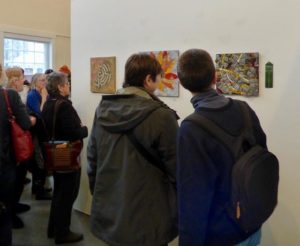
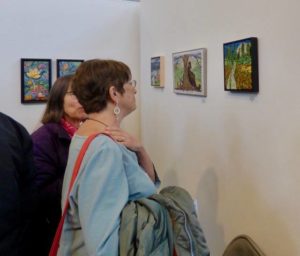
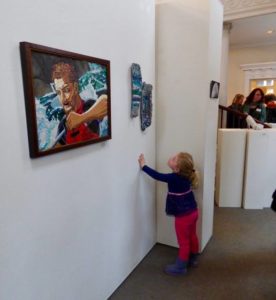
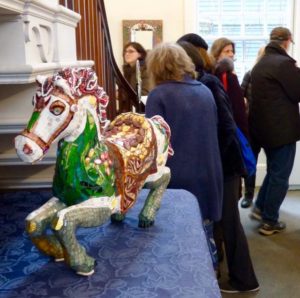
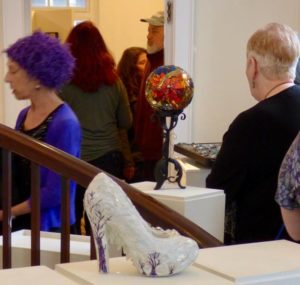
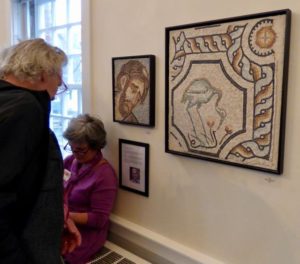
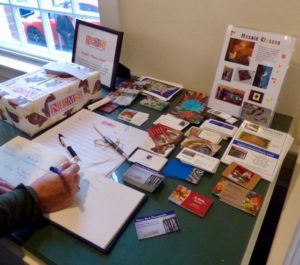
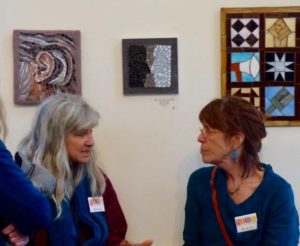
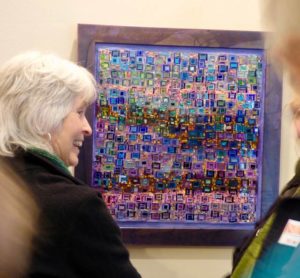
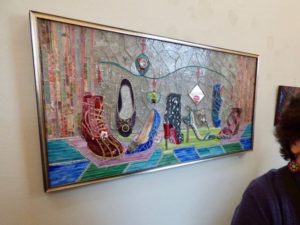
The opening for the Somerville Museum mosaic art show was fabulous and had a great turn out! Check out the pictures below.











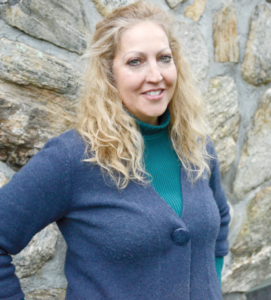 A message from Deb Aldo: Dear NEMS Members- As the Co-Chair of SAMA I’d like to give you a bit of background on my mosaic journey and let you know about some of the benefits of attending the conference. I started to make mosaics in 1997. Back then there were no associations near me, no one teaching classes, just books in a library which were dated and dog eared but fascinating nonetheless. When I started, my work was not very good. I worked in the landscape and construction industry, earning my degree in Landscape Architecture. I joined SAMA and quickly found others who were on a similar mosaic related trajectory. SAMA provided an opportunity to focus on what I wanted out of mosaics: The pursuit of general knowledge, history, process and technical skills. To my surprise, I actually became a “real” artist. I took classes for years at the conferences and was the recipient of the Robin Brett Scholarship, a terrific learning and traveling experience. Becoming a professional mosaic artist occurred in part because of SAMA. As some of you may know I work locally and nationally and on large scale architectural installations with a specialty in pebble mosaics. Not everyone who makes mosaics wants to make a living at it. For many it is an escape and release from daily stressors. Even if you make mosaics as a hobby they are a creative endeavor, they feed the soul, they help get us out of ourselves and deeper into ourselves. Art makes people happy, so does making it.
A message from Deb Aldo: Dear NEMS Members- As the Co-Chair of SAMA I’d like to give you a bit of background on my mosaic journey and let you know about some of the benefits of attending the conference. I started to make mosaics in 1997. Back then there were no associations near me, no one teaching classes, just books in a library which were dated and dog eared but fascinating nonetheless. When I started, my work was not very good. I worked in the landscape and construction industry, earning my degree in Landscape Architecture. I joined SAMA and quickly found others who were on a similar mosaic related trajectory. SAMA provided an opportunity to focus on what I wanted out of mosaics: The pursuit of general knowledge, history, process and technical skills. To my surprise, I actually became a “real” artist. I took classes for years at the conferences and was the recipient of the Robin Brett Scholarship, a terrific learning and traveling experience. Becoming a professional mosaic artist occurred in part because of SAMA. As some of you may know I work locally and nationally and on large scale architectural installations with a specialty in pebble mosaics. Not everyone who makes mosaics wants to make a living at it. For many it is an escape and release from daily stressors. Even if you make mosaics as a hobby they are a creative endeavor, they feed the soul, they help get us out of ourselves and deeper into ourselves. Art makes people happy, so does making it.
1. The conference is NEVER less expensive than when it’s local. Yes, we know, New England is a big place but considering that both Detroit and Philadelphia were close, both were still a plane ride and a hotel stay away. Drive or train in and out, stay with a friend. This may be the only time SAMA will be in New England. “Are there any NEMS members who would be willing to host out-of-towners so they do not have to pay for a hotel?” Glynda Benham, SAMA Boston 2018 Co-Chair
2. Connect with other like minded individuals. Some are regular folks, some are more “name brand” but everyone is willing to share their company and their knowledge. Many who have gone to multiple conferences are still friends with folks we met at the first conference.
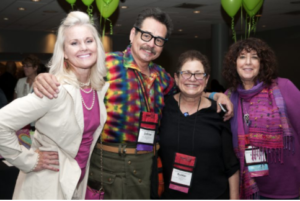 3. World class instruction, business classes and just for fun classes. You can learn new skills in a matter of days.
3. World class instruction, business classes and just for fun classes. You can learn new skills in a matter of days.
4. Cory Huff is speaking this year. He is an artist and mentor on marketing and the business of art. He’s an excellent speaker talking about useful information! A must see.
5. There are two major exhibits at the conference- IMA and the Invitational. The participating artists have been honing their craft for years. The is a range of styles, materials, storytelling, intellectual process or just breathtaking beauty to behold. The exhibits are filled with creative original work. Looking at their art is an inspiration which often leads to an urge to make better art because you now know what better is!
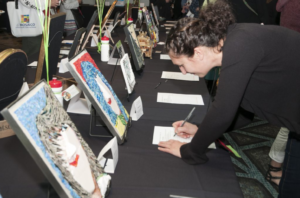 6. A mind boggling array of events, only a few are listed here: Meet up Meals, Mosaic Salon where SAMA members can sell their non juried work. Volunteer opportunities, Tours in and out of Boston, a swag bag filled with info and mosaic goodies, events both at the conference and throughout the city.
6. A mind boggling array of events, only a few are listed here: Meet up Meals, Mosaic Salon where SAMA members can sell their non juried work. Volunteer opportunities, Tours in and out of Boston, a swag bag filled with info and mosaic goodies, events both at the conference and throughout the city.
7. Mosaic Marathon- The opportunity to have social and mosaic experience on a large scale public project. Anyone at any level can show up and work for an hour or for days on end.
8. The Cafe, and other lecture series, Professional Development, hours of relevant lectures all mosaic related.
9. Total immersion into the mosaic world for a few days. With lasting impressions and resulting friends!
10. NEMS is offering a scholarship of $150 off the conference fee to the first 10 people who register with SAMA. Provide proof of registration from SAMA and NEMS sponsorship fund will reimburse $150. First come first served, preference to those who have NOT been to a SAMA conference. Available to NEMS members with current registration.
A few words from the new Vice President of NEMS and another of our members who is a long time conference attendee-
“I had the opportunity to go to the SAMA conference last year in Detroit. I am relatively new to the mosaic community and did not know what to expect. What a got was more than I could have imagined. The opportunity to be with others that have the same passion. Seeing the exhibits was absolutely amazing. I met people who truly enjoyed discussing their art and how they work. The other fun thing for me was the vendor marketplace: I was able to see and touch before purchasing new materials. found the vendors to be very knowledgeable. With the conference in Boston this year it is a tremendous opportunity for us all to go!” Beth Goulet
“If you’re connected with NEMS you have taken the step to meet people in the New England area who are involved with making and appreciating mosaics. Going to the SAMA conference extends that step to the next level: Those NEMS members who are professional mosaic artists, who teach their techniques and show their work nationally and internationally are almost all SAMA members and have been attending the conferences for years. NEMS greatly benefits from their expertise and from the associations they have made with other professional, talented mosaic artists from around the country and the world. At a SAMA conference you are right in the thick of it, shoulder to shoulder meeting people you wouldn’t otherwise, seeing pieces of art up close that you usually see in a book or on your computer screen. Being exposed to art and artists working in the highest level of mosaic art is an experience not to be missed.” Carol Cataldo
Carol A. Krentzman, a mosaic artist, and Helen M. Salzberg, a collage artist, teamed up to create a body of work called “Fabulous Faces in Translation.” Carol used Helen’s specially created collages to design and create her mosaics. The video “Two Women Making Art” tells their histories, shows them working in their studios and tours their recent exhibit at The Center for Arts in Natick.
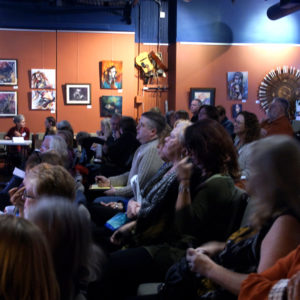
NEMS celebrated its second year at an Annual Meeting on November 5, 2017 in Framingham, MA. Fortyeight members gathered for a program that included a critique of mosaic art made by nine members. Cynthia Fisher, and Cathleen Newsham were the critique team that provided feedback on what worked in each piece and made suggestions for improvement.

At the annual meeting, we elected a new slate of officers for the organization. They are:
Michael Ferriera, President
Beth Goulet, Vice President
Terry Bromfield, Treasurer
Mary Bowles, Secretary

We also introduced the co-chairs of all committees as well as our new webmaster, Cassie Doyon.
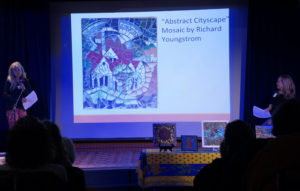
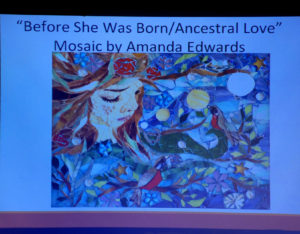
Amy Marks discussed the results of the annual member survey and suggested that the new officers address two issues: making the exhibition process more inclusive so all members can participate and create programs in regions outside the Boston metro area. In addition, members wanted more programs that would help them improve their mosaic skills and techniques.

We updated everyone on the SAMA Conference and introduced our first community services project at Ronald McDonald in Portland, ME. In addition, we introduced the concept of an All member exhibition at the Somerville Museum this winter.
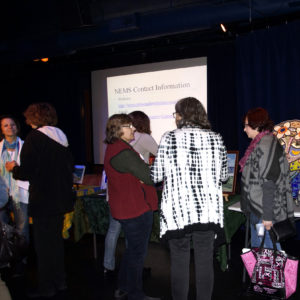
We ended with a talk on photographing mosaics with your mobile phone by Carrie Fradkin.
We ended with snacks, networking and viewing members’ mosaics in the Salon. A great end to a great year!
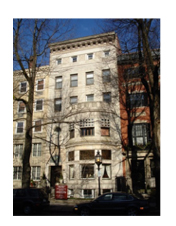 Earlier this year, 30 NEMS members went on a private tour of the mosaics and stained glass at Ayer Mansion, Boston’s Tiffany Treasure. Our tour guide provided us with stories about the family who commissioned the building and put the project in historic context. After the tour, we were treated to a catered reception. A wonderful event. Thanks, Suzanne! If you missed it, you can go on a public tour. See schedule at http://www.ayermansion.org/Visit.html.
Earlier this year, 30 NEMS members went on a private tour of the mosaics and stained glass at Ayer Mansion, Boston’s Tiffany Treasure. Our tour guide provided us with stories about the family who commissioned the building and put the project in historic context. After the tour, we were treated to a catered reception. A wonderful event. Thanks, Suzanne! If you missed it, you can go on a public tour. See schedule at http://www.ayermansion.org/Visit.html.
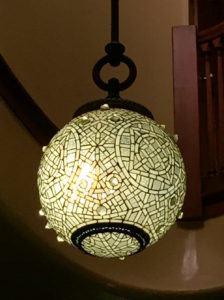
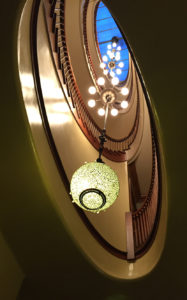 Here’s what we learned. The Ayer Mansion was built between 1899 and 1902 for businessman and art collector Frederick Ayer. It is the only surviving residence created by American artist and designer, Louis Comfort Tiffany.
Here’s what we learned. The Ayer Mansion was built between 1899 and 1902 for businessman and art collector Frederick Ayer. It is the only surviving residence created by American artist and designer, Louis Comfort Tiffany.
At the Mansion, we viewed the Tiffany-designed stone and glass mosaics, graceful metalwork, Favrile glass vases, custom furniture, intricate plaster work, and elaborate art glass windows as well as exterior mosaics.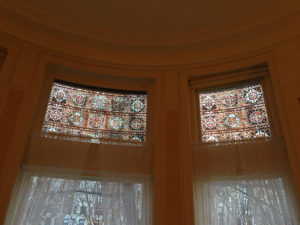
Tiffany was influenced by the art of the East. We saw this in the rich Near Eastern patterns and color combinations in his mosaics and glass.
In the entrance hall of the Ayer Mansion, Tiffany combined mosaics and stained glass to transform an ordinary hall into a sumptuous, luminous stage set, perhaps intended for amateur theatricals and musicals.
The mosaics of the apse-like stair opening are composed of semitransparent glass backed by metallic foil to reflect light, creating an iridescent effect. The three-dimensional effect of the tromp l’oeil pavilion on the stair landing was created through Tiffany’s characteristic use of “plating” or layering clear and opaque glasses to add depth of color and three dimensionality. The adjoining marble engaged columns, raised on a slightly projecting plane, further add to the optical illusion.
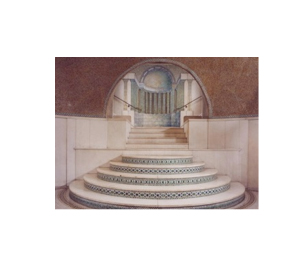
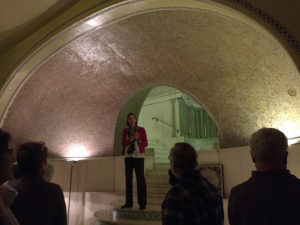
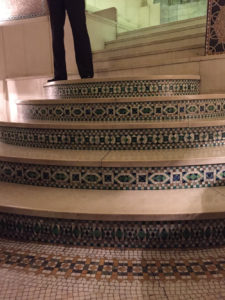
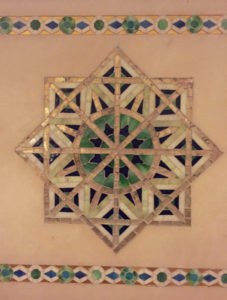
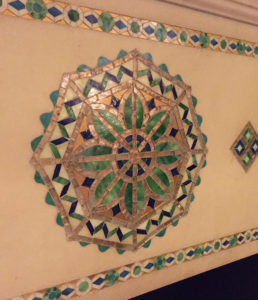
 March 11, 2017, Emerson Umbrella Center for the Arts, Concord, MA
March 11, 2017, Emerson Umbrella Center for the Arts, Concord, MA
Cindy pointed out that her perspective is not that of a pricing professional, but reflects her experiences as a professional mosaic artist.
Mosaic making is a very hard way to earn a living. It can be useful to write a business plan for your business, but you need to be very proactive about marketing yourself and getting work. And since mosaics are so labor intensive, you cannot expect to make the same hourly rate as a painter might, for example.
There are many things to consider when pricing your mosaic art.
The time it takes you to make a square foot of mosaic
Log ALL your time from sketch to completion, including time with client, purchasing materials, etc.
Direct cost of materials per square foot: substrate, material, adhesive, grout, sticky paper, use of tools, etc.
Your goal is to pass on your costs for the project.
Ask your accountant if you have questions about how to account for some of the costs if you aren’t sure.
Shipping costs should be kept separate and charged separately. Make sure you tell the client that this will be a separate and additional cost. (If you make shipping containers, you should not be charging your artist fee for that).
What you want/need to earn per hour to cover your direct and indirect costs
Indirect costs include:
Not all your hours as a small business owner are billable.
You can charge more than usual cost per hour to account for some of these costs. Include:
Health insurance, disability, life insurance
Company match on 401k
Mileage reimbursement
Cost of paid continuing education, training, conferences
Coffee, snacks, and periodic lunches
Regular raises and bonuses
Vacation, sick days, holiday pay
Business expenses of home office
Cost of transporting materials (not shipping, though), restocking
What do you want to earn per hour? You should think about:
Your expertise (eg., you are expected to make a mosaic that won’t fall apart)
Years of experience
Cost of learning from/eating your mistakes
Knowledge of what price the market will bear
Subjective, depends on location, demographics, size of selling environment, etc.
Making money on low-end items is difficult
You could do the reverse and think FIRST about how much the market will bear and then design/create your work around those limitations.
 Additional things to consider in pricing:
Additional things to consider in pricing:
Learn what market prices are for the types of work you do.
Sonia King’s general price (a few years ago) was $300/hour installed for public installations. Public installations usually support a much higher cost/hour than projects for individuals. (This is similar logic to the price an illustrator charges a publisher for artwork that goes in book with a large print run vs. a piece that is sold to an individual.)
Galleries: 50:50 is standard ratio of distribution of money received on artwork. This means you have to price your work at double the price you already established (which, because it’s a mosaic, is high by comparison with painting, etc.) Make sure to double your materials costs as well. Thus it’s hard to put mosaics in galleries and have them be affordable.
Remember that you should charge as close as you possibly CAN to the real price. If you undercharge, it hurts the art community at large because good artists who price based on real costs won’t be able to sell by comparison with what you charge.
Establish a first payment in case you don’t complete the job. (eg., the whole cost will be $3000, and the initial payment will be $300, which includes certain deliverables).
Really important to tell your customers what goes into your pricing so they understand, before you even get to the selling price.
Try to be flexible about what you do (e.g., fill only part of the allotted space to save the client some money; use paint for the background, etc).
You can also sell prints of your mosaics, etc., if you want to sell something at a lower cost. Can be helpful if you are trying to make a living. Of course a print sacrifices lose some of what makes mosaics special (e.g., 3D, light reflection).
Advice from the audience: Create a contract that spells out what you will do, as specifically as possible, and what’s included. Anything outside that is out of scope and requires renegotiation.
Pricing form from state of New Hampshire Liquor Authority (See Appendix A or link to original online:
http://www.nh.gov/liquor/store69artworkrfp.pdf
Pricing formulas:
Formula 1: Square feet x dollars (per sq foot)
Formula 2: (hourly wage x hours spent) + cost of materials